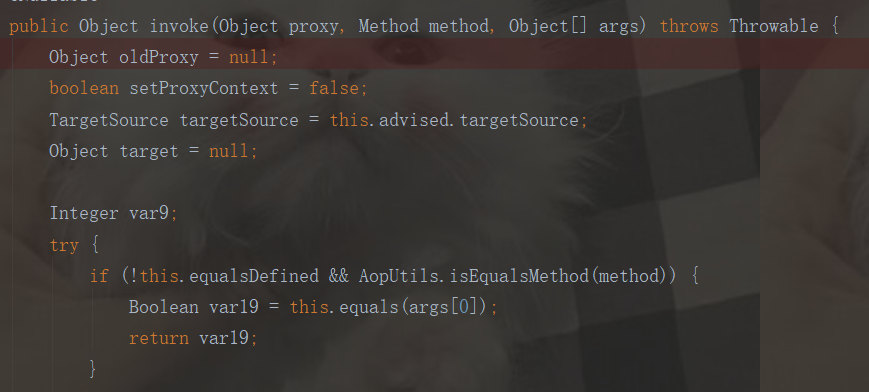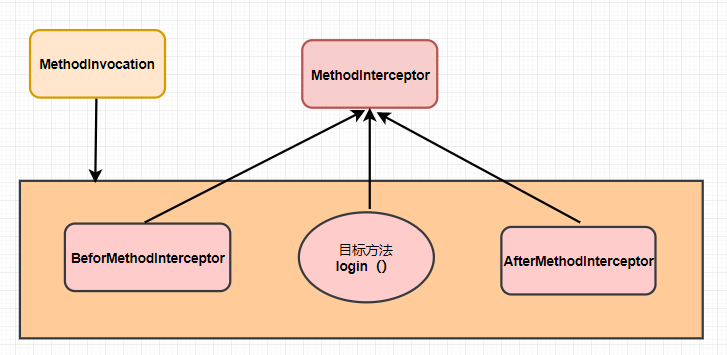Spring5.0原始碼深度解析之SpringBean的Aop通知呼叫鏈原始碼分析

思考:springAOP底層運用了什麼設計模式?
生成代理類:代理設計模式、底層五個通知形成呼叫鏈採用:責任鏈設計模式
下面我們回顧下SpringAop實現流程:
1、配置@EnableAspectJAutoProxy
2、@Import(AspectJAutoProxyRegistrar.class)往IOC容器中注入SpringAOP切面類
3、registerAspectJAnnotationAutoProxyCreatorIfNecessary()註冊切面類
4、AnnotationAwareAspectJAutoProxyCreator.class註冊到IOC容器中,【AOP的入口】
5、postProcessAfterInitialization
6、wrapIfNecessary()判斷該物件是否在AOP的掃包範圍內
7、createAopProxy()判斷被代理類是否實現了介面,如果有實現了介面的化,是採用JDK動態代理,否則情況下就使用CGLIB代理
8、使用JdkDynamicAopProxy()方法實現代理類
9、最終執行目標方法的時候,就會進入到JdkDynamicAopProxy 的invoke()方法
10、底層使用集合存放使用通知,然後再使用責任鏈設計模式迴圈的呼叫





如果呼叫了目標方法,則最終進入invoke方法

SpringBean的生命週期
主要靠的是後置處理器BeanPostProcessor:在Bean物件初始化前後做一些增強
AnnotationAwareAspectJAutoProxyCreator的祖宗是BeanPostProcessor
純手寫SpringAop呼叫鏈思路
【0】環繞通知之前執行→【1】前置通知→目標方法→【2】後置通知→【3】環繞通知之後執行
責任鏈設計模式,底層通過遞迴演算法+責任鏈
如何存放起來:使用集合存放這些通知,集合當中不存放我們的方法,只存放鏈,那麼如何插入我們的目標方法?
純手寫SpringAop呼叫鏈

MethodInterceptor 介面
public interface MethodInterceptor {
/**
* 定義共同通知骨架
*/
public void invoke(MethodInvocation methodInvocation) throws InvocationTargetException, IllegalAccessException;
}
BeforMethodInterceptor 前置通知
public class BeforMethodInterceptor implements MethodInterceptor {
public void invoke(MethodInvocation methodInvocation) throws InvocationTargetException, IllegalAccessException {
System.out.println(">>>>前置通知<<<<");
// 執行我們的目標方法
methodInvocation.process();// 遞迴呼叫
}
}
AfterMethodInterceptor後置通知
public class AfterMethodInterceptor implements MethodInterceptor {
public void invoke(MethodInvocation methodInvocation) throws InvocationTargetException, IllegalAccessException {
// 執行我們的前置通知
methodInvocation.process();
System.out.println(">>>後置通知<<<");
}
}
AroundMethodInterceptor 環繞通知
public class AroundMethodInterceptor implements MethodInterceptor {
public void invoke(MethodInvocation methodInvocation) throws InvocationTargetException, IllegalAccessException {
System.out.println("環繞通知在目標方法之前執行..");
methodInvocation.process();
System.out.println("環繞通知在目標方法之後執行..");
}
}
UserService
public class UserService {
public void login(String userName, Integer age) {
System.out.println("userName:" + userName + ",age:" + age);
}
}
MethodInvocation 能夠把鏈串起來
public interface MethodInvocation {
//呼叫鍊形成
public void process() throws InvocationTargetException, IllegalAccessException;
}
DefaultMethodInvacation 實現通知串起來
public class DefaultMethodInvacation implements MethodInvocation {
/**
* 存放所有的通知
*/
private List<MethodInterceptor> listMethodInterceptor;
private Object target;// 目標物件
private Method method;// 目標方法
private Object args[];// 目標引數
// 最終使用反射機制執行目標方法
private int index;// 記錄當前鏈呼叫的位置
public DefaultMethodInvacation(List<MethodInterceptor> listMethodInterceptor, Object target, Method method, Object[] args) {
this.listMethodInterceptor = listMethodInterceptor;
this.target = target;
this.method = method;
this.args = args;
}
/**
* 呼叫鍊形成
*/
@Override
public void process() throws InvocationTargetException, IllegalAccessException {
if (index == listMethodInterceptor.size()) {
method.invoke(target, args); // 執行目標
return;
}
MethodInterceptor methodInterceptor = listMethodInterceptor.get(index++);
methodInterceptor.invoke(this);
}
}
執行結果:

>>>>前置通知<<<<
環繞通知在目標方法之前執行..
userName:mayikt,age:12
環繞通知在目標方法之後執行..
>>>後置通知<<<
本文參考
螞蟻課堂:http://www.mayikt.co
